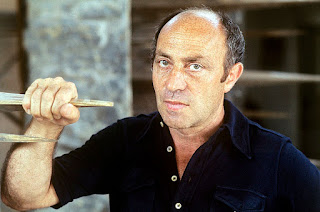Romagnolo artist best known for his Sphere within Sphere series
 |
| Arnaldo Pomodoro, pictured in 1975, is regarded as one of Italy's most influential sculptors |
Pomodoro’s first Sphere within Sphere (Sfera con Sfera) was installed in the Cortile della Pigna courtyard at the Vatican Museums in Roma in the 1960s and he has subsequently produced versions for many locations around the world.
These include Trinity College, Dublin, the United Nations Plaza and Mount Sinai Hospital in New York, museums in Washington D.C., Tehran and Tokyo and on the beach front at Pesaro, another Adriatic resort not far from Pomodoro’s birthplace.
Broadly speaking, the sculptures, which contain a smaller sphere at the centre of the larger, broken sphere, separated by layers of what look a little like the inner workings of a watch, represent the fragility of the world or of society and the complexities that lie beneath the surface.
.jpg) |
| Pomodoro's first Sfera con Sfera, which is at the centre of the Cortile della Pigna at the Vatican |
Yet his curiosity with forms of art led him to study subjects from stage set design to jewellery design in his spare time.
It was after he moved to Milan in 1954, when the city was seen to be at the cutting edge of theatre, art and music, that he began to pursue his interest more vigorously. He started to frequent the Jamaica Bar in the Brera district, a popular meeting place for artists and intellectuals.
His earliest sculptures were shown at the Galleria del Naviglio in Milan in 1955. Arnaldo’s younger brother, Giò, was similarly keen to develop his talent for sculpture and the two participated in the Venice Biennale.
Pomodoro spent the early part of the 1960s in the United States after obtaining a grant to study American art. He exhibited at a number of festivals, in 1964 winning the International Prize for Sculpture at the São Paulo Biennale and also the National Prize for Sculpture at the XXXII Venice Biennale.
He remained in the United States, becoming an artist in residence at Stanford University, and then at University of California, Berkeley.
 |
| Disco Grande in Milan is one of Pomodoro's personal favourites |
Other works by Pomodoro to have found permanent homes include a large fibreglass crucifix for the Cathedral of St. John the Evangelist in Wisconsin, which features a 14-foot (4.27m) diameter crown of thorns which hovers over the figure of Christ.
In Copenhagen, Denmark, a decorative pillar with a sphere on its top, called Solar Form, in the Amaliehaven park close to Amalienborg Palace, was sculpted by Pomodoro, who is also responsible for a pyramid named Forms of Myth, which was bought by the city of Brisbane in Australia after being unveiled at Brisbane's World Expo. Another pyramid sculpture, Wing Beat: Homage to Boccioni, sits in the centre of a large fountain in Los Angeles.
Pomodoro, now 96, has described his Disco Grande, which can be found in Piazza Filippo Meda in the centre of Milan, as one of the works that has given him the most personal pride. The 4.5m (15ft) bronze disc, which weighs around seven tons and has two faces, has five large cracks extending to its outer edges, with a design that evokes an exploding sun or star at the centre.
The sculptor talks of Milan as the city that adopted him and the disc, which has echoes of Leonardo da Vinci’s Vitruvian Man, the drawing he made in the late 15th century of a male figure within a circle, as representing the dynamism, optimism and solar strength of the city.
Travel tip:
Pomodoro's Sfera con Sfera on the promenade
in Pesaro, where he worked as a young man
Pesaro, where Pomodoro worked after graduating from college, is a coastal city in Le Marche with a 15th century Ducal Palace, commissioned by Alessandro Sforza. It has become known as the city of music because the opera composer Gioachino Rossini was born there in 1792. The Rossini Opera Festival has taken place in Pesaro every summer since 1980 and the town is home to the Conservatorio Statale di Musica Gioachino Rossini, which was founded from a legacy left by the composer. In addition to its long stretch of sandy beach, which extends for around 7km (4.3 miles), the city, which has a population of almost 100,000, is dubbed the Città della Bicicletta (the City of the Bicycle) for its extensive network of cycle paths.
Travel tip:A characteristic narrow street in
Milan's fashionable Brera district
The Brera district of Milan is thought to derive its name from the Lombardic word ‘brayda’, which was ninth century military terminology for ‘an area cleared of trees’. Today, it is one of Milan’s most fashionable neighbourhoods, its narrow streets lined with trendy bars and restaurants. It has been traditionally home to the city’s artists and writers, which gives it a Bohemian feel that has brought comparisons with Montmartre in Paris. The Brera is home to the Brera Academy of Fine Arts and the Brera Art Gallery. The Jamaica dal 1911 Ristorante, where Pomodoro and his artist friends were regulars, can be found in Via Brera, the street that dissects the area, between Via Pontaccio and Via Fiori Chiari.
Also on this day:
1945: The birth of partisan Giuseppina Tuissi
1980: The birth of tennis champion Francesca Schiavone
2008: The death of actor and voice dubber Claudio Capone
